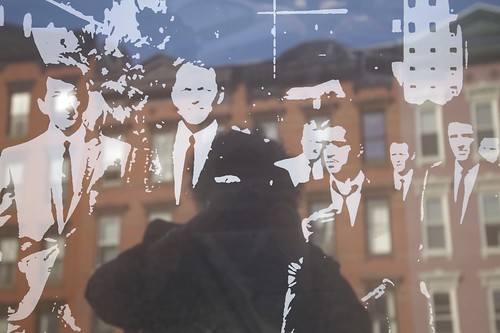From 1979, posted online June 5, 2016.
Pages in this blog
▼
Wednesday, June 29, 2016
Tuesday, June 28, 2016
Cabbage
This is a nice photo. I like it, I really do. But why is it my most popular photo on Flickr, at least as measured by the number of views (3907 as of today, 3702 for second most popular)?
Fans and Scholars Working on the History of Science Fiction
Stefana Forlini, Uta Hinrichs, and Bridget Moynihan, The Stuff of Science Fiction: An Experiment in Literary History, DHQ 2016, vol 10, #1.
Abstract: This article argues for a speculative, exploratory approach to literary history that incorporates information visualization early on into, and throughout, the research process. The proposed methodology combines different kinds of expertise — including that of fans and scholars in both literary studies and computer science — in processing and sharing unique cultural materials. Working with a vast fan-curated archive, we suggest tempering scholarly approaches to the history of science fiction (SF) with fan perspectives and demonstrate how information visualization can be incorporated into humanistic research processes, supporting exploration and interpretation of little-known cultural collections.
A Shared-Expertise Approach to Cultural Analysis
In her recent work, How We Think, N. Katherine Hayles suggests that Digital Humanities (DH) research offers new opportunities for creative collaborations across disciplines and with "expert amateurs" beyond "academic walls" [Hayles 2012, 36]. Such collaborations require that we acknowledge the value of different kinds of expertise, welcome cross-pollination of approaches and promote open access to rare materials and to analytical activities. In this article, we argue for a collaborative, shared-expertise approach to literary and/or cultural collections and showcase our own take on such an approach. The work we present is the result of the collaboration between an expert amateur who compiled one of "the most important research archives" of SF [Latham 2010, 161] and scholars in both literary studies and computer science.
In an attempt to reconsider numerous neglected specimens of proto/early SF and to devise a DH approach to literary history suited to popular genres, our project specifically aims
- to investigate how the Bob Gibson anthologies of speculative fiction — unique, hand-crafted and fan-curated anthologies of SF’s "great unread" [Moretti 2000, 54] — can contribute to scholarly assessments of the evolution of SF, and
- to develop information visualizations that enable researchers, students, fans, and the general public to explore the collection from different perspectives, promoting fluid movement between close and distant reading.
Visualizations are key to our collaborative and exploratory approach. Rather than using visualizations solely to display the final "results" of our research, we are experimenting with evolving interactive visualizations in tandem with our research questions and ongoing investigations of Gibson’s untapped collection of little-known materials. The visualizations are thus integral to our research "process", shaping and being shaped by our research questions and ongoing findings, and are not simply tools used as a means to an end. This exploratory approach is necessary because very little is known about the primary materials we are investigating. Moreover, we want to make visible our research process as it is impacted by digital tools and to remain open to unforeseen questions and research avenues that arise through our first-hand interactions with the collection and with the developing visualizations.
In describing this process, our article makes two main contributions: we outline our emergent method for the study of early SF in the context of the Gibson Collection, adapting Franco Moretti’s [Moretti 2005] evolutionary approach to genre, and we demonstrate how integrating information visualization early on in the research process can support exploration and guide the interpretation of vast, largely unknown literary collections. We begin by introducing the Gibson anthologies and their unique characteristics before describing our theoretical approach to investigating and classifying their material contents, and the design considerations underlying our visualizations. Because the focus of this paper is primarily on the value of visualizations employed throughout the research process, we describe our initial visual explorations and findings as well as new iterations of our visualizations as they evolved. Finally, we identify the benefits and limitations of our approach to early SF as it has developed so far and outline future steps.
* * * * * *
Michal Pollan talks about psychedelics
At Mother Jones:
You know Michael Pollan from his blockbuster book The Omnivore's Dilemma, an entertaining exploration of the thorny decisions surrounding what we eat. Or maybe you read his most recent title, Cooked, which was adapted by Netflix as a four-part documentary series.But the celebrity author hasn't always been so obsessed with what people put on their plates. "Before I started writing about food, my focus was really on the human relationship to plants," Pollan explained on the most recent episode of Bite, Mother Jones' new food politics podcast. "Not only do plants nourish us bodily—they nourish us psychologically."
The thought spurred Pollan to leave the kitchen and take a residency at Harvard, where he's researching flora with psychedelic properties for a new book. Part of the project covers recent experimental trials using psilocybin (a compound found in magic mushrooms) to treat cancer patients' anxiety about death, which he wrote about for The New Yorker.
A Skeptical View of AI
Five years ago Skeptic published A.I. GONE AWRY: The Futile Quest for Artificial Intelligence by Peter Kassa. It's pretty good. Three paragraphs near the beginning:
Duplicating or mimicking human-level intelligence is an old notion — perhaps as old as humanity itself. In the 19th century, as Charles Babbage conceived of ways to mechanize calculation, people started thinking it was possible — or arguing that it wasn’t. Toward the middle of the 20th century, as mathematical geniuses Claude Shannon, Norbert Wiener, John von Neumann, Alan Turing, and others laid the foundations of the theory of computing, the necessary tool seemed available.In 1955, a research project on artificial intelligence was proposed; a conference the following summer is considered the official inauguration of the field. The proposal is fascinating for its assertions, assumptions, hubris, and naïveté, all of which have characterized the field of A.I. ever since. The authors proposed that ten people could make significant progress in the field in two months. That ten-person, two-month project is still going strong — 50 years later. And it’s involved the efforts of more like tens of thousands of people.A.I. has splintered into three largely independent and mutually contradictory areas (connectionism, computationalism, and robotics), each of which has its own subdivisions and contradictions. Much of the activity in each of the areas has little to do with the original goals of mechanizing (or computerizing) human-level intelligence. However, in pursuit of that original goal, each of the three has its own set of problems, in addition to the many that they share.
The article has sections for each of those three areas. The conclusion:
With admirable can-do spirit, technological optimism, and a belief in inevitability, psychologists, philosophers, programmers, and engineers are sure they shall succeed, just as people dreamed that heavier-than-air flight would one day be achieved.88 But 50 years after the Wright brothers succeeded with their proof-of-concept flight in 1903, aircraft had been used decisively in two world wars; the helicopter had been invented; several commercial airlines were routinely flying passengers all over the world; the jet airplane had been invented; and the speed of sound had been broken.After more than 50 years of pursuing human- level artificial intelligence, we have nothing but promises and failures. The quest has become a degenerating research program89 (or actually, an ever-increasing number of competing ones), pursuing an ever-increasing number of irrelevant activities as the original goal recedes ever further into the future — like the mirage it is.
The article's followed by 89 footnotes, many with one or more like.
Monday, June 27, 2016
How is the human brain like the Internet, metabolic networks, relations among English words, US airport networks, Hungarian road networks
András Gulyás, József J. Bíró, Attila Kőrösi, Gábor Rétvári & Dmitri Krioukov
Nature Communications 6, Article number: 7651 doi:10.1038/ncomms8651
Received 04 December 2014 Accepted 26 May 2015 Published 03 July 2015
Abstract: Common sense suggests that networks are not random mazes of purposeless connections, but that these connections are organized so that networks can perform their functions well. One function common to many networks is targeted transport or navigation. Here, using game theory, we show that minimalistic networks designed to maximize the navigation efficiency at minimal cost share basic structural properties with real networks. These idealistic networks are Nash equilibria of a network construction game whose purpose is to find an optimal trade-off between the network cost and navigability. We show that these skeletons are present in the Internet, metabolic, English word, US airport, Hungarian road networks, and in a structural network of the human brain. The knowledge of these skeletons allows one to identify the minimal number of edges, by altering which one can efficiently improve or paralyse navigation in the network.
A Brexit State of Mind @3QD: The Vision Thing
My latest post is up at 3 Quarks Daily, A Brexit State of Mind: The Vision Thing. I start with a dream–not a nightmare, but not a laughriot either–move into Brexit, dip into history, then on to the AI singularity and the end of science. I conclude with Tim Burke on Hillary Clinton.
Interspersed with five flix. These aren’t among them, but who knows? they might have been.
Sunday, June 26, 2016
Networks in the Middle Ages
Calculating the Middle Ages? The Project "Complexities and Networks in the Medieval Mediterranean and Near East" (COMMED)
(Submitted on 11 Dec 2015)
The project "Complexities and networks in the Medieval Mediterranean and Near East" (COMMED) at the Division for Byzantine Research of the Institute for Medieval Research (IMAFO) of the Austrian Academy of Sciences focuses on the adaptation and development of concepts and tools of network theory and complexity sciences for the analysis of societies, polities and regions in the medieval world in a comparative perspective. Key elements of its methodological and technological toolkit are applied, for instance, in the new project "Mapping medieval conflicts: a digital approach towards political dynamics in the pre-modern period" (MEDCON), which analyses political networks and conflict among power elites across medieval Europe with five case studies from the 12th to 15th century. For one of these case studies on 14th century Byzantium, the explanatory value of this approach is presented in greater detail. The presented results are integrated in a wider comparison of five late medieval polities across Afro-Eurasia (Byzantium, China, England, Hungary and Mamluk Egypt) against the background of the {\guillemotright}Late Medieval Crisis{\guillemotleft} and its political and environmental turmoil. Finally, further perspectives of COMMED are outlined.
| Comments: | 23 figures |
| Subjects: | Physics and Society (physics.soc-ph); Adaptation and Self-Organizing Systems (nlin.AO) |
| Journal reference: | medieval worlds, 1.2 (2015) 100 - 127 |
| DOI: | 10.1553/medievalworlds_no2_2015s100 |
| Cite as: | arXiv:1606.03433 [physics.soc-ph] |
| (or arXiv:1606.03433v1 [physics.soc-ph] for this version) |
Saturday, June 25, 2016
Respose to Sad Music
Eerola T, Peltola H-R (2016) Memorable Experiences with Sad Music—Reasons, Reactions and Mechanisms of Three Types of Experiences. PLoS ONE 11(6): e0157444. doi:10.1371/journal.pone.0157444
Abstract: Reactions to memorable experiences of sad music were studied by means of a survey administered to a convenience (N = 1577), representative (N = 445), and quota sample (N = 414). The survey explored the reasons, mechanisms, and emotions of such experiences. Memorable experiences linked with sad music typically occurred in relation to extremely familiar music, caused intense and pleasurable experiences, which were accompanied by physiological reactions and positive mood changes in about a third of the participants. A consistent structure of reasons and emotions for these experiences was identified through exploratory and confirmatory factor analyses across the samples. Three types of sadness experiences were established, one that was genuinely negative (Grief-Stricken Sorrow) and two that were positive (Comforting Sorrow and Sweet Sorrow). Each type of emotion exhibited certain individual differences and had distinct profiles in terms of the underlying reasons, mechanisms, and elicited reactions. The prevalence of these broad types of emotional experiences suggested that positive experiences are the most frequent, but negative experiences were not uncommon in any of the samples. The findings have implications for measuring emotions induced by music and fiction in general, and call attention to the non-pleasurable aspects of these experiences.
From the discussion:
Defusing the paradox of pleasurable sadness
The results help us to contextualise several of the conflicting results obtained in the previous studies of music and sadness. First of all, the paradox of pleasurable sadnesss is actually less puzzling if one acknowledges that there are different types of “sadnesses”. Past empirical studies have put particular emphasis on the pleasurable experiences induced by sad music [5, 6, 9, 53], which could be close to Sublime Sorrow or at least Comforting Sorrow identified in the present study. Only few empirical studies have acknowledged the fact that the experiences induced by sad music might actually be genuinely negative, harrowing and unpleasant [18, 22] although such experiences are acknowledged by ethnomusicological field studies [15, 54]. The third factor in this study (Grief-Stricken Sorrow) seems to portray such affective experiences, wherein the thematic analysis of the experiences’ content revealed themes of bereavement, mourning, and loss.Secondly, there seems to be a clear difference between an aesthetic emotion, such as the one labelled here as Sublime Sorrow, and the other type of positive experience, Comforting Sorrow. The latter is related to other people, to social relationships, and is typically more reflective than the experiences induced by moving music, which is one of the hallmarks of Sublime Sorrow. When looking at the qualitative data, lyrics seemed to play a crucial role within the experiences relating to difficult situations of life. This observation stands out in interesting light when comparing it to a finding by Brattico and her colleagues [12], who discovered that lyrics (or vocal information in general) may be crucial for defining the sadness of a musical piece. Furthermore, in their study, participants judged instrumental sad music as more pleasant and beautiful than music containing lyrics. Thus, it might be that Sublime Sorrow is more relevant for the experiences of listening to instrumental music, whereas Grief-Stricken Sorrow and Comforting Sorrow are induced by vocal music with meaningful lyrics. However, since our participants did not consistently identify the type of music they were describing, this connection can only be speculated.If the differences related to sadness are unacknowledged, this could lead research to either focus on mood regulation strategies [8] if the emphasis is placed on experiences related to Comforting Sorrow, or to aesthetic experiences [55] when the Sublime Sorrow is the actual object of study. In some cases, both types of experiences seem to be combined [6], but such strategies need more refined treatment of the experiences involved in sadness before they will lead to genuinely novel insights on the topic.
The Universal Map, Apple or Google?
From 2011 to 2015 Justine O'Beirne led Apple's mapping efforts. He' been writing some interesting essays. From 2015, The Universal Map: Cartography's Most Important Moment is Rapidly Approaching:
Just thirty years ago—and for most of human history—a cartographer would make a map, print and distribute it, and hope that maybe a few thousand or so people would ever use it before it went out of date. Apart from a handful of atlases and classroom maps, most maps had small, local audiences, went out of date quickly, and were often difficult to read and understand—let alone share.
Fast forward to today, and cartography has since undergone a number of profound changes:
- An unprecedented level of detail is now available to the average person, for little or no cost. ...
- Maps are now always up to date. ...
- Maps fit us, regardless of who or where we are. ...
- Maps are integrated with robust search & routing. ...
- Advanced sensors keep us apprised of our current location, 24 hours a day. ...
These are all profound technical changes, 10x improvements that are hugely impactful in their own right. But there’s an even deeper, more profound cultural change seemingly on the horizon:And he's just published the first part of a four-part comparison between Google Maps and Apple Maps, the current leading candidates for the first universal map. The first part looks at map contents, cities, roads, and places:
FOR THE FIRST TIME IN HUMAN HISTORY, THE MAJORITY OF THE WORLD MIGHT SOON BE USING THE SAME MAP.
We looked at 54 pairs of maps across three cities (New York, San Francisco, and London) and found several significant differences (POI = point of interest):
- Apple Maps, on average, labels more cities than Google at every zoom.
- Google Maps, on average, labels more roads than Apple on nearly every zoom.
- For two-thirds of zooms, both maps generally show the same number of roads. For the remaining third, Apple almost always shows more roads.
- Both maps, on average, label a similar number of POIs—but have only 10% of their POIs in common on an average zoom.
- Both maps also prioritize different kinds of POIs: Google Maps heavily prioritizes transit, while Apple prioritizes landmarks. Apple also generally shows a greater number of POI categories on a given zoom—and shows twice as many restaurants and shops as Google.
Thursday, June 23, 2016
The Birth of the Drum Set
For the drums are not one instrument, but many. The drum set is a hybrid of instruments from around the world, from cultures that were assembling in port cities like New Orleans. The snare and bass drum were once slung over shoulders in European militaries, the drum heads pulled tight by ropes, and that tradition carried over to American armies. Chinese immigrants came to the United States because they were hired or forced into labor, and they brought with them their own centuries-old theater traditions, highlighted by colorfully-painted tom-toms that made a beautiful full sound, distinct from snares or bass drums. Cymbals evolved from bronze cisterns made in places like Turkey and China; they were later pounded into flatter shapes and supplied to countries around Europe for operas and military music, becoming so popular in the United States that Zildjian, the original Turkish cymbal company, eventually moved to Massachusetts.
The Dee Dee Chandler and the groove:
In a comment on the article Samm Bennett links to his page of vintage drum kits from the 1920s and 1930s.The drum set was coalescing at the same time jazz was, and they helped to push each other along. The distillation of the different rhythmic instruments into one set to be played by one person meant that the rhythmic interpretation was now codified in one human body. For centuries, percussion instruments in classical music were played by different people, and, perhaps partly for that reason, “groove” and feel were never paramount. For the first time in history, one human body was able to create the pulse, the back beat, the syncopation, and the texture of a percussion part all by itself. The possibilities for more forward, propulsive, linear grooves turned the musical world upside down for decades to come.Edward “Dee Dee” Chandler was a drummer living in New Orleans at the turn of the century. He played music in two worlds: the down and dirty shows in the brothels of Storyville and the high-society gigs at places like the Grunwald Hotel off of Canal Street. He was of mixed race and could roughly pass for white, but when Plessy v. Ferguson was handed down, it included rules limiting the freedom of anyone with even a drop of mixed-race blood from going to places like the Grunwald.But again, from limitation comes innovation. Other people had done such a thing before, but Dee Dee Chandler was perhaps one of the first drummers to use a makeshift pedal to play the bass drum with his foot while playing snare with his hands. Before that you would have to have a different musician play each instrument or use a style called “double drumming,” which involved playing bass drum and snare drum simultaneously with both hands and no feet, limiting the kind of rhythms you could express on the snare. The weird contraption that allowed Chandler to play the bass drum with his foot was not smooth like today’s pedals and must have been a challenge to play. But it was a point on the evolution of the drum set as a more dynamic instrument that, in just a few decades, would become the lynchpin of jazz ensembles, whose rhythmic playfulness created some of the best music of the century. And it was the music created in those poorer places, with audiences innovating new dance steps like swing, that made jazz music so alive.
Wednesday, June 22, 2016
Viet Thanh Nguyen's Pulitzer and the continuing apocalypse, now
LOS ANGELES — Viet Thanh Nguyen has been wrestling with “Apocalypse Now” for most of his life — as a boy, a college student, a scholar, a writer of fiction. The movie was initially a source of pain, then a puzzle to be understood, and finally an inspiration for his novel about a Vietnamese spy, “The Sympathizer.”Even now, after a rapturous reception for the novel, his first, that included the 2016 Pulitzer Prize for fiction, Mr. Nguyen’s feelings about Francis Ford Coppola’s 1979 war epic are still somewhat raw.
I was struck by this paragraph:
“People just like me were being slaughtered,” Mr. Nguyen said. “I felt violated.” A decade later, as a student at Berkeley, he talked about the scene for a film class. He began rationally, he remembered, and then realized his voice was full of rage. “It was an antiwar movie about the war in Vietnam, but the movie was about Americans,” he said. “The Vietnamese were silent and erased.”
Apocalypse Now was loosely based on Heart of Darkness. China Achebe said much the same thing about Heart of Darkness in his essay, "An Image of Africa: Racism in Conrad's 'Heart of Darkness'" (Massachusetts Review. 18. 1977):
Students of Heart of Darkness will often tell you that Conrad is concerned not so much with Africa as with the deterioration of one European mind caused by solitude and sickness. They will point out to you that Conrad is, if anything, less charitable to the Europeans in the story than he is to the natives, that the point of the story is to ridicule Europe's civilizing mission in Africa. A Conrad student informed me in Scotland that Africa is merely a setting for the disintegration of the mind of Mr. Kurtz.Which is partly the point. Africa as setting and backdrop which eliminates the African as human factor. Africa as a metaphysical battlefield devoid of all recognizable humanity, into which the wandering European enters at his peril. Can nobody see the preposterous and perverse arrogance in thus reducing Africa to the role of props for the break-up of one petty European mind? But that is not even the point. The real question is the dehumanization of Africa and Africans which this age-long attitude has fostered and continues to foster in the world.
Tuesday, June 21, 2016
Limitations of the Google Books Corpus for Drawing Inferences about Cultural and Linguistic Evolution
Pechenick EA, Danforth CM, Dodds PS (2015) Characterizing the Google Books Corpus: Strong Limits to Inferences of Socio-Cultural and Linguistic Evolution. PLoS ONE 10(10): e0137041. doi:10.1371/journal.pone.0137041
Abstract: It is tempting to treat frequency trends from the Google Books data sets as indicators of the “true” popularity of various words and phrases. Doing so allows us to draw quantitatively strong conclusions about the evolution of cultural perception of a given topic, such as time or gender. However, the Google Books corpus suffers from a number of limitations which make it an obscure mask of cultural popularity. A primary issue is that the corpus is in effect a library, containing one of each book. A single, prolific author is thereby able to noticeably insert new phrases into the Google Books lexicon, whether the author is widely read or not. With this understood, the Google Books corpus remains an important data set to be considered more lexicon-like than text-like. Here, we show that a distinct problematic feature arises from the inclusion of scientific texts, which have become an increasingly substantive portion of the corpus throughout the 1900s. The result is a surge of phrases typical to academic articles but less common in general, such as references to time in the form of citations. We use information theoretic methods to highlight these dynamics by examining and comparing major contributions via a divergence measure of English data sets between decades in the period 1800–2000. We find that only the English Fiction data set from the second version of the corpus is not heavily affected by professional texts. Overall, our findings call into question the vast majority of existing claims drawn from the Google Books corpus, and point to the need to fully characterize the dynamics of the corpus before using these data sets to draw broad conclusions about cultural and linguistic evolution.
Sunday, June 19, 2016
Sex? What's the Difference? It's not binary; it's complex.
Claire Ainsworth in Nature, from February 15, 2016:
Sex can be much more complicated than it at first seems. According to the simple scenario, the presence or absence of a Y chromosome is what counts: with it, you are male, and without it, you are female. But doctors have long known that some people straddle the boundary — their sex chromosomes say one thing, but their gonads (ovaries or testes) or sexual anatomy say another. Parents of children with these kinds of conditions — known as intersex conditions, or differences or disorders of sex development (DSDs) — often face difficult decisions about whether to bring up their child as a boy or a girl. Some researchers now say that as many as 1 person in 100 has some form of DSD2.
When genetics is taken into consideration, the boundary between the sexes becomes even blurrier. Scientists have identified many of the genes involved in the main forms of DSD, and have uncovered variations in these genes that have subtle effects on a person's anatomical or physiological sex. What's more, new technologies in DNA sequencing and cell biology are revealing that almost everyone is, to varying degrees, a patchwork of genetically distinct cells, some with a sex that might not match that of the rest of their body. Some studies even suggest that the sex of each cell drives its behaviour, through a complicated network of molecular interactions. “I think there's much greater diversity within male or female, and there is certainly an area of overlap where some people can't easily define themselves within the binary structure,” says John Achermann, who studies sex development and endocrinology at University College London's Institute of Child Health.
These discoveries do not sit well in a world in which sex is still defined in binary terms. Few legal systems allow for any ambiguity in biological sex, and a person's legal rights and social status can be heavily influenced by whether their birth certificate says male or female.
Yet if biologists continue to show that sex is a spectrum, then society and state will have to grapple with the consequences, and work out where and how to draw the line. Many transgender and intersex activists dream of a world where a person's sex or gender is irrelevant. Although some governments are moving in this direction, Greenberg is pessimistic about the prospects of realizing this dream — in the United States, at least. “I think to get rid of gender markers altogether or to allow a third, indeterminate marker, is going to be difficult.”
So if the law requires that a person is male or female, should that sex be assigned by anatomy, hormones, cells or chromosomes, and what should be done if they clash? “My feeling is that since there is not one biological parameter that takes over every other parameter, at the end of the day, gender identity seems to be the most reasonable parameter,” says Vilain. In other words, if you want to know whether someone is male or female, it may be best just to ask.
Trump conquers Japan, and then the world
The strangest Trump video ever, in which Trump is elected world president, and if you suspect that it may not be shooting straight, you'd be correct:
It's by Mike Diva, "an American video director, special effects artist, musician and YouTube personality." Wikipedia says:
Diva's intent was to "seem obnoxiously pro-Trump" while doing the opposite, with the production quality so good that viewers would ask: "Why would a Japanese ad agency make this?" Indeed, many early online comments mistook the video for a genuine ad, despite Trump's being (briefly) depicted as giving a Nazi salute amid swastikas and ultimately transforming into an earth-destroying robot. The video was shot over a month and a half with virtually no budget and stars the cosplayer and wig stylist known as Sushi Monster.
A short interview with Diva at Slate. Linguistically informed commentary at Language Log.
Saturday, June 18, 2016
Jerry Seinfeld & the Craft of Comedy
Another working paper. URL at Academia.edu:
Abstract: Stand-up comedy is tightly constructed despite appearing to be casual and improvised. In one section this working paper examines a comedy bit about donut holes and finds in it a metaphysical dimension that is, in fact, typical of Seinfeld’s comedy. Another section shows how a conversation with President Barack Obama hinges on the distinction between a social role and the person playing that role. A final piece looks at the wide range of ephemeral phenomena around which Seinfeld crafts his comedy.
CONTENTS
Introduction: A Comedian’s Mind 1
Jerry Seinfeld and Barack Obama Have a Meeting of the Minds 3
Seinfeld Through the Donut Hole 11
Single Shots: Seinfeld’s Ongoing Anatomy of Life and Comedy 15
Introduction: A Comedian’s Mind
Jerry Seinfeld started out as and remains a stand-up comedian. I’ve never seen one of his live shows. I didn’t really become aware of him until I started watching Seinfeld, and that’s when I learned that he did stand-up. Stand-up, of course, is live performance, something I’m familiar with as a musician. And that’s where I connect with him, the rigors of live performance and preparing for it.
One of the pieces I’ve collected here, “Seinfeld Through the Donut Hole,” is specifically about that. It’s a light analysis of a specific comic bit, one about donut holes and fat people. The point about donut holes is that there’s nothing there. The point about fat people is that eating donut holes is not a viable weight reduction strategy. Just how Seinfeld connects these two, that’s the art and craft of comedy.
The first piece, “Jerry Seinfeld and Barack Obama Have a Meeting of the Minds,” is a bit different. It centers on an episode from Seinfeld’s current web-based series, Comedians in Cars Getting Coffee. As you may know, the premise is simple: Seinfeld, who loves and collects cars, meets a comedian in a car specifically selected for them. The two go off, Seinfeld driving, and get coffee–and, more often than not, breakfast or lunch as well. They’re chatting all the time.
The conversation is “real” in the simple sense that it is not scripted. But the show we see is nonetheless meticulously crafted. Upwards of three hours of whatever (it’s not film and it’s not videotape; it’s digital bits stored in what? flash memory?) is edited down to 15 or 20 minutes of program. That makes it watchable, entertaining, and even enlightening, whereas the raw footage, if you can call it that, would be a snooze fest.
Barack Obama, of course, is not a comedian. But he’s got a sense of humor. That, and the fact that he’s President of the United States, is why Seinfeld did an episode with him. Just who approached whom about doing this, Seinfeld to Obama, Obama to Seinfeld, I don’t know.
The conversation is real in the same sense that all these CCGC conversations are real; it’s not scripted. Most of the conversation is casual chit chat. But there’s a moment where it turns real in a deeper sense, and that’s what my piece is about. The deeper revelation starts when Seinfeld asks: “How many world leaders do you think are just completely out of their mind?” It pierces the veil when Seinfeld tells Obama “the work was joyful. And interesting, and that was my focus.” That’s what makes Jerry Seinfeld tick, and, we are to infer, Barack Obama too.
The third and last piece, “Single Shots: Seinfeld’s Ongoing Anatomy of Life and Comedy,” is a bit different. “Single Shot” is a figure of speech: a single shot of cream in your coffee; different versions of a single bit, motif, or incident from different episodes of Comedians in Cars Getting Coffee. Think of it as compressed commentary on Seinfeld. The show came to be known as a show about nothing, but it really isn’t. That is, it isn’t about nothing. It’s about the metaphysical (yes, I said “metaphysical”) oddities of everyday life, the oddities through which stand-up comedians drive their tightly constructed comedic contraptions. Each single shot focuses on one oddity, thereby bringing it into metaphysical relief.
Metaphysical? There’s that word again.
Don’t ask, don’t tell.
OK.
Thursday, June 16, 2016
MIckey Mouse in Shanghai, but only for 43%
Think of it what you will, but Disney is a cultural formation that has traveled around the world, first in cartoons and associated merchandise, then live action films, and then theme parks. The latest and largest theme park has just opened in Shanghai (NYTimes):
The park — Disney’s first on the Chinese mainland — was held up as nothing less than a historic symbol of United States-China relations. Mr. Iger read aloud a letter sent by President Obama that heralded the resort as capturing “the promise of our bilateral relationship.” In a letter of his own, China’s president, Xi Jinping, called the project, which took nearly two years of bruising negotiations to realize, a sign of China’s “commitment to cross-cultural cooperation and our innovation mentality in the new era.”On a lighter note, Wang Yang, one of China’s vice premiers, stood onstage in front of the park’s lavish storybook castle and joked that the rain was a sign of good luck — the “rain of U.S. dollars and RMB,” he said, referring to China’s currency, the renminbi. Disney owns 43 percent of the resort, with the majority stake held by a Chinese state-controlled consortium.
Robert Iger, Disney's CEO, took a special interest in planning the park:
On his tour, Mr. Iger walked through a 15-acre garden in the center of the park designed for older visitors. In part because of China’s longtime one-child policy, Shanghai Disneyland must have strong intergenerational appeal. As “Let’s Go Fly a Kite” from “Mary Poppins” played on the Fantasia Carousel sound system, Mr. Iger pointed toward a grove of cherry trees where 12 mosaics depicted Disney characters in Chinese zodiac style.“We think this will be a very popular photo op,” he said. Disney learned at Hong Kong Disneyland, which opened in 2005, that the Chinese love to take pictures of themselves in front of whimsical facades. (Mr. Iger’s zodiac symbol — he was born in 1951 — is a rabbit, represented on the wall by Thumper from “Bambi.”)
Wednesday, June 15, 2016
Louis CK on Hillary, Bernie, and The Donald (& a bonus on performing)
From an interview in Vulture:
Sometimes I think the system is so deeply fucked up that somebody as disruptive as Bernie — maybe he doesn’t even do a good job as president but he jars something loose in our system and something exciting happens. I mean, Hillary is better at this than any of these people. The American government is a very volatile, dangerous mechanism, and Hillary has the most experience with it. It’s like if you were on a plane and you wanted to choose a pilot. You have one person, Hillary, who says, “Here’s my license. Here’s all the thousands of flights that I’ve flown. Here’s planes I’ve flown in really difficult situations. I’ve had some good flights and some bad flights, but I’ve been flying for a very long time, and I know exactly how this plane works.” Then you’ve got Bernie, who says, “Everyone should get a ride right to their house with this plane.” “Well, how are you going to do that?” “I just think we should. It’s only fair that everyone gets to use the plane equally.” And then Trump says, “I’m going to fly so well. You’re not going to believe how good I’m going to fly this plane, and by the way, Hillary never flew a plane in her life.” “She did, and we have pictures.” “No, she never did it.” It’s insane.
On performing stand-up:
I think I’m a better comedian overall than I was back then, but back then I was better at performing. When you’re that greased up onstage, you just have a higher comedy IQ. It’s the ability to go on any stage in the country and be perfectly present and able to maneuver the set and have great timing. Some of it is being in physical shape. When you’re under pressure or strain, you get dumb, you know? It’s why I started working out in boxing gyms, because you watch a guy who’s fighting, he’s in a terribly arduous moment and he’s making intelligent choices. So to me that’s when you’re 55 minutes deep into your sixth show of the week, in your fifth city of the week. You have to be able to be great right in that moment. You have to be, “You’re not going to believe what I’m going to do next.” The audience is tired, and you have to have more energy than anyone in the room. You have to be able to control the pace. At my show last night, I was talking to myself a little bit while my mouth was moving delivering material. I was thinking, You’re going too fast. Cool it. You have plenty of time and loads of shit to say.
Trump and Fear as an Instrument in American Politics
From the NYTimes:
Exploitation of fear has been part of the American political playbook since colonial pamphleteers whipped their neighbors into a frenzy over British misrule. It took on new potency in the nuclear age with Lyndon Johnson’s “Daisy” ad against Barry Goldwater in 1964 and Jimmy Carter’s warnings about Ronald Reagan’s finger on the button in 1980.But Mr. Trump — who drew harsh condemnation from President Obama on Tuesday — has intensified the power of fear in presidential politics by demonizing an entire religious group. And he has expanded the use of that power by stirring up fear in the aftermath of national traumas, like the San Bernardino, Calif., attack and now the Orlando shooting, that traditionally elicited measured and soothing responses from political leaders.
In the wake of the Orlando attack:
Julian E. Zelizer, a professor of history and public affairs at Princeton, said Mr. Trump was using the attack as an I-told-you-so moment. “He would see this as a confirmation of all the things he has been saying about the threat the United States faces and the need to be more aggressive,” he said.Professor Zelizer cast Mr. Trump as part of a political strain dating at least from the 1950s. “When the United States is faced with national security threats or national security crises, you play to fear, you play to the anger of the electorate and you offer promises of military might as the solution,” he said.In the jittery aftermath of a terrorist attack, people find themselves leaning on “emotional reasoning, as opposed to thinking through these kinds of issues rationally,” said Samuel Justin Sinclair, an assistant professor of psychology at Harvard Medical School and a co-author of “The Psychology of Terrorism Fears.”“It’s dangerous to think about making major policy decisions reactively and from a position of fear,” Dr. Sinclair said.He added: “Whether you agree with his politics or not, I think Mr. Trump’s more aggressive tactics may be one attempt at trying to assert some level of control in a situation where people feel scared and a loss of control — as a means of helping them to feel safer. The dilemma then becomes whether supporting these more extreme policies justifies the ends — particularly in terms of how it changes us as a society.”
Tuesday, June 14, 2016
Friday, June 10, 2016
Cat and Mouse in “The West Wing”
I’ve been watching The West Wing for the third time. As you may know, it’s a TV series that ran from September 1999 through to May 2006 and centered on Josiah Bartlett, played by Martin Sheen. Bartlet is from an old Yankee family and is a Nobel Laureate in economics. He’s also President of the United States, hence the show’s title.
I suppose there’s lots one could say about the show–I obviously like it. But at the moment I have just one observation and it’s about how Bartlet enacts his dominance.
He’s erudite, can be charming, and has a sense of humor. He delights in his knowledge and frequently lectures others on this or that. Sometimes he does this with several people at a time. And sometimes only one-on-one. Sometimes it’s late at night and people are tired.
But he’s the President and so they listen politely, “Yes, Mr. President.” They have no choice. At times this has made me twitch in my seat as I watch. It’s almost painful. Bartlet’s being enthusiastic. And why not? He’s not the one being subjected to this nonsense. Ever watch a cat play with a mouse? That’s what this is, except that the mouse is allowed to live so that it can thank the cat for being played with.
Computer Writes Sci-Fi Flick
Sunspring is a short sci-fi flick that was scripted by an AI that, apparently, calls itself Benjamin. The story is on Ars Technica. I was pointed there by Tyler Cowen.
I watched three minutes out of nine before embedding it above. The first half of those 3 minutes was meta: credits and a bit of how-we-did-it. From the story:
Benjamin is an LSTM recurrent neural network, a type of AI that is often used for text recognition. To train Benjamin, Goodwin fed the AI with a corpus of dozens of sci-fi screenplays he found online—mostly movies from the 1980s and 90s. Benjamin dissected them down to the letter, learning to predict which letters tended to follow each other and from there which words and phrases tended to occur together. The advantage of an LSTM algorithm over a Markov chain is that it can sample much longer strings of letters, so it's better at predicting whole paragraphs rather than just a few words. It's also good at generating original sentences rather than cutting and pasting sentences together from its corpus. Over time, Benjamin learned to imitate the structure of a screenplay, producing stage directions and well-formatted character lines. The only thing the AI couldn't learn were proper names, because they aren't used like other words and are very unpredictable. So Goodwin changed all character names in Benjamin's screenplay corpus to single letters. That's why the characters in Sunspring are named H, H2, and C. In fact, the original screenplay had two separate characters named H, which confused the humans so much that Sharp dubbed one of them H2 just for clarity.
And this:
For Sharp, the most interesting part of the Benjamin experiment has been learning about patterns in science fiction storytelling. Benjamin's writing sounds original, even kooky, but it's still based on patterns he's discovered in what humans write. Sharp likes to call the results the "average version" of everything the AI looked at. Certain patterns kept coming up again and again. "There's an interesting recurring pattern in Sunspring where characters say, 'No I don’t know what that is. I’m not sure,'" said Goodwin. "They're questioning the environment, questioning what’s in front of them. There's a pattern in sci-fi movies of characters trying to understand the environment." Sharp added that this process has changed his perspective on writing. He keeps catching himself having Benjamin-like moments while working: "I just finished a sci-fi screenplay, and it’s really interesting coming off this experience with Benjamin, thinking I have to have somebody say 'What the hell is going on?' Every time I use his tropes I think, oh of course. This is what sci-fi is about." Sharp's next project will be directing a movie called Randle Is Benign, about a computer scientist who creates the first superintelligent computer in 1981. "It's uncanny how much parts of the screenplay echo the experience of working with Benjamin," he said.
Wednesday, June 8, 2016
Cultural Style: Software, Jamming & #DH
Prompted by some recent reading in digital humanities (aka DH), I'm bumping this to the top of the queue. It started with Scott Enderle's The Radical Potential of RDF Dimension Reduction? That took me to Miriam Posner, What’s Next: The Radical, Unrealized Potential of Digital Humanities, and that, in turn, shuttled me off to an interview in which Tara McPherson argues, "early developments in digital computing were also intertwined with shifting racial codes in the U.S. and beyond."
In the piece that follows I take up a similar conjunction, computing and race, though to a somewhat different end and with a different valence. It dates back to the previous millennium. IBM is no longer on the ropes, as it was when I wrote it, though it is a very different company, with a different product mix. But it hasn't quite regained its past glory either. That is gone, perhaps forever. There are other players in the game. The once mighty Microsoft is still mighty, but it has been outstripped by Google and, of all companies, Apple. Still, there's a basic truth stored away in these words and that truth doesn't change just because the high tech world keeps whirlin' around. You might also check out this historical fantasy in the subject of Independence Day.
In the piece that follows I take up a similar conjunction, computing and race, though to a somewhat different end and with a different valence. It dates back to the previous millennium. IBM is no longer on the ropes, as it was when I wrote it, though it is a very different company, with a different product mix. But it hasn't quite regained its past glory either. That is gone, perhaps forever. There are other players in the game. The once mighty Microsoft is still mighty, but it has been outstripped by Google and, of all companies, Apple. Still, there's a basic truth stored away in these words and that truth doesn't change just because the high tech world keeps whirlin' around. You might also check out this historical fantasy in the subject of Independence Day.
* * * * *
21st C = von Neumann * Armstrong^2
Why is America the software center of the Universe?
Why is America the software center of the Universe?
Because it is also the Rap-Rock-Funk-Soul-Jazz-Blues
center of the Universe. What does that have to do
with the If-Then-Else imperatives of byte busting?
Technology is not just technique. It is style and
attitude. You can't write great software if your
soul was nurtured on the mechanical clockwork and
internal combustion rhythms of the Machine Age. You
must free yourself from the linear flow of
mechanical time and learn to improvise order from
the creative chaos lurking in the multiple
intersecting flows of the digital domain.
Roll over Beethoven, it's Jimi Hendrix time.
* * * * *
Cases in point: Steve Wozniak took time out
from Apple to produce rock and roll concerts.
Microsoft was co-founded by a guitar-playing
Jimi Hendrix fan, Paul Allen. Borland International
is the brainchild of barbarian jazz saxophonist
Philippe Kahn. Xerox and Apple guru Alan GUI
Kay worked his way through graduate school as
a jazz musician. Lotus founder Mitch Kapor
has taken to riding the informatic frontier
with Grateful Dead lyricist John Perry Barlow.
Friday, June 3, 2016
Intimate Partner Violence in the Great Recession
A recent paper from Schneider, Harknett, and Mclanahan. Here's the abstract:
In the United States, the Great Recession has been marked by severe negative shocks to labor market conditions. In this study, we combine longitudinal data from the Fragile Families and Child Wellbeing Study with Bureau of Labor Statistics data on local area unemployment rates to examine the relationship between adverse labor market conditions and intimate partner violence between 1999 and 2010. We find that rapidly worsening labor market conditions are associated with increases in the prevalence of violent/controlling behavior in marriage. These effects are most pronounced among whites and those with at least some post-secondary education. Worsening economic conditions significantly increase the risk that white mothers and more educated mothers will be in violent/controlling marriages rather than high quality marital unions.
Nietzsche Like You've Never Seen Him! – Zarathustra in the Style of Dr. Seuss
John Holbo has been writing and illustrating On Beyond Zarathustra, which is Nietzsche in the style of Theodore Geisel (aka Dr. Seuss). Here's the Flickr album:
Just click on the arrows ('<' and '>') to scan through the pictures. Click directly on the image to go to the Flickr album for the set. Holbo says a bit about the project at Crooked Timber.
Just click on the arrows ('<' and '>') to scan through the pictures. Click directly on the image to go to the Flickr album for the set. Holbo says a bit about the project at Crooked Timber.
Thursday, June 2, 2016
The high life
In any case, 57th Street is now dubbed Billionaire’s Row, and wealth has reached new altitudes. Advances in skyscraper technology have much to do with this. William F. Baker, who helped engineer the Burj Khalifa in Dubai, at 2,717 feet the world’s tallest tower, recently explained the engineering behind life above 800 feet. Engineers, he said, who long ago figured out how to make sure skyscrapers won’t topple over, are focused more and more these days on the trickier problem of making people inside feel secure. It’s a challenge because very tall, very slim buildings are designed, like airplane wings, to bend not break. An average person starts worrying about movement in a high-rise long before there’s anything approaching a threat to safety. Mild jostling that you take for granted in a car or train can provoke panic at 100 stories, even if you’re still safer in the building than in the car.Incredible efforts now go into mitigating those effects. Today’s superslender towers are outfitted with sophisticated counterweights, or dampers, and other movement-tempering devices, as they are also outfitted with elevators that speed tenants to their aeries but not so swiftly that you will perceive any troubling G-forces. Something around 30 feet per second seems to be an ideal velocity, suggesting there may be an ultimate height for luxury towers — not because we can’t engineer a mile-high building but because rich tenants won’t abide elevators that take several minutes to reach apartments for which they paid the annual expenditures of the Republic of Palau.
Walter Freeman: My Legacy: A Launch Pad for Exploring Neocortex
I had quite a bit of correspondence with Walter Freeman at the end of the last century and in the early years of this one. I was using his conceptions of neurodynamics in thinking about music and so discussed such things with him.
* * * * *
This is the keynote address and talk 3 (of 31) at the Conference on Brain Network Dynamics held at the University of California at Berkeley on January 26-27, 2007. Speaker is the late Walter J Freeman, Department of Molecular & Cell Biology, University of California at Berkeley, Berkeley, CA 94720. http://sulcus.berkeley.edu/.
Slides for this talk (with transcript!) are available in both PDF and Powerpoint format at Freeman's lab HERE. Click on the link "Talk & Symposia Video MPEGs" and then "WJF UCB Brain Dynamics '07 Conference Talk: My Legacy: A Launch Pad for Exploring Neocortex". But then again, maybe this will take you directly to his talk. As indeed it does. But not as it's linked out of his website, but as it lives at Archive.org.
It's a challenging talk, assuming some familiarity with the material. I have some familiarity, just some (much of the technical material is above my pay grade), but still, there's something there, if only for the range of material Freeman covers.
Abstract: Fifty years ago EEG was widely regarded as noise, the roar of a crowd. It still is, advisedly, because cortical neurons form great crowds, and the task of systems neuroscience is to comprehend them. I perceived EEG as an opportunity to make a contribution. I chose to study three-layered allocortex in the olfactory system as simpler than neocortex yet closer to the senses than the hippocampus. I began by pulsing it with pairs of electric shocks in order to identify a small-signal near-linear range, in which I could model the dynamics with linear equations. From the patterns of relaxation on perturbation — evoked potentials — I modeled the system with differential equations, evaluated the parameters, solved them to simulate the evoked potentials, and deduced the mechanisms of stabilization. I summarized 20 years of linear analysis in my 1975 book, from which I concluded that I had reached the limits of linear analysis. Trying to understand brain function that way was like trying to cross an ocean in a dugout canoe. I conceived a boundary in the imaginary axis of the complex plane. Contemplating that, I felt as Isaac Newton felt, playing with pebbles on a seashore.
In the following 30 years I have explored the design of foundations for ocean crossings. You will hear five promising approaches in this Conference on Brain Network Dynamics. Steve Bressler will describe nonlinear metastability in terms of basin-attractor theory deriving in part from Hermann Haken’s synergetics. Robert Kozma will describe phase transitions in terms of neuropercolation, which he derives from random graph theory. Bert Dreyfus will describe the isomorphism he perceives between brain dynamics and the phenomenology of Martin Heidegger and Maurice Merleau-Ponty. Giuseppe Vitiello will describe the mapping of dissipative brain dynamics into quantum field theory, stemming from the pioneering work of Ricciardi and Umezawa. I will try to show how to map solution sets of nonlinear differential equations into a phase portrait in the self-organizing, far-from-equilibrium thermodynamics that leads from disorder to order: Ilya Prigogine’s ‘dissipative structures’ that feed on energy.
None of these five tools can be used alone with full success; each approach contributes necessary insights. Together they provide a launch pad for vehicles that will carry us arduously but freely to new discoveries across the ocean of nonlinear brain dynamics before us. Like other true explorers, we don’t know what we will find, and we don’t yet have the proper framework in which to describe whatever is there. This broad view from an open mind is my legacy.





















